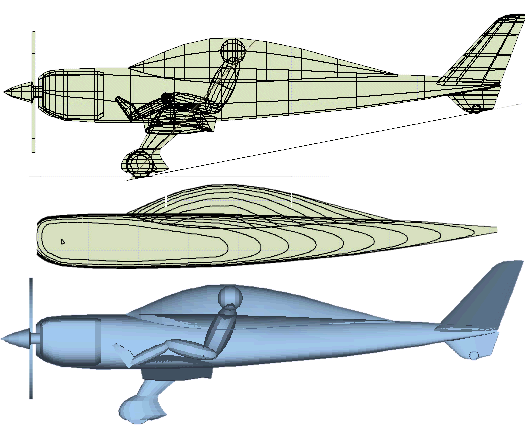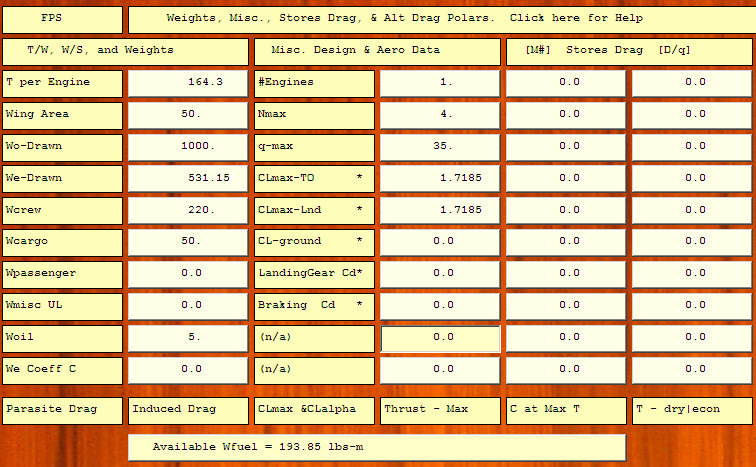![[RDS]](rds.jpg) |
![[RDS Aircraft Design Software]](titletext_rds.gif) |
![[RDS]](rds.jpg) |
![[RDS Aircraft Design Software]](titletext_rds.gif) |
RDSwin is over 100,000 lines of original Windows source code dedicated to the development, analysis, and optimization of new aerospace vehicle concepts. RDSwin features a 3-D CAD module for design layout and has analysis modules for aerodynamics, weights, propulsion, and cost. Also included are aircraft sizing, mission analysis, and complete performance analysis including takeoff, landing, rate of climb, Ps, fs, turn rate, and acceleration. RDS provides graphical output for drag polars, L/D ratio, thrust curves, flight envelope, range parameter, and more. The Professional version of RDSwin has automatic optimization and numerous other features to support the daily work of the design professional.
RDSwin follows the design and analysis methods of the best-selling textbook "Aircraft Design: A Conceptual Approach.", by Dr. Daniel P. Raymer. These methods are distilled from the classical and time-proven techniques commonly used in industry design groups for early visibility into design drivers and options. RDSwin automates these methods to permit a tremendous quantity of calculation including trade studies and optimization in the very early stages of design.
 The RDSwin Design Layout Module is an original, built-in CAD program developed especially for
the conceptual design of new aircraft and spacecraft. RDS-DLM is uniquely
suited to Aircraft Conceptual Design because it knows what an airplane is. RDS-DLM has dozens
of airplane-specific design capabilities to rapidly create and modify your design.
Design capabilities include wings, tails, fuselages, nacelles, seats,
canopies, and virtually any other components. RDS allows interactive assembly
of the aircraft in any view, "flying" the parts into position with the mouse.
RDS-DLM even uses the aircraft industry SAWE Group Weight Statement component categories
to identify the designís various parts and to automatically pass the geometric data to the RDS analysis modules.
The RDSwin Design Layout Module is an original, built-in CAD program developed especially for
the conceptual design of new aircraft and spacecraft. RDS-DLM is uniquely
suited to Aircraft Conceptual Design because it knows what an airplane is. RDS-DLM has dozens
of airplane-specific design capabilities to rapidly create and modify your design.
Design capabilities include wings, tails, fuselages, nacelles, seats,
canopies, and virtually any other components. RDS allows interactive assembly
of the aircraft in any view, "flying" the parts into position with the mouse.
RDS-DLM even uses the aircraft industry SAWE Group Weight Statement component categories
to identify the designís various parts and to automatically pass the geometric data to the RDS analysis modules.
RDSwin analysis is calculated from inputs entered by the user in a number of spreadsheet-like grid arrays. Column and row labels prompt for the required inputs, which can be stored, edited, and printed. "Fudge factor" inputs are provided to permit adjusting analysis results based upon actual aircraft data or projections for advanced technologies.
The RDSwin Aerodynamics Module estimates parasite drag (subsonic and supersonic), drag due to lift, lift curve slope, and maximum lift from a user-defined input matrix. Analysis methods are based upon classical techniques, as defined in Raymer's textbook. Subsonic parasite drag is estimated by the component buildup method. Supersonic wave drag is determined by the equivalent Sears-Haack technique. Transonic drag is determined by empirical fairing between Mdd and the supersonic wave drag. Drag due to lift is calculated by the leading-edge suction method using Cl-alpha calculated with DATCOM methods. Maximum lift is calculated using DATCOM methods, as are longitudinal stability and control.
 Weights and balance are estimated statistically from inputs defined in a spreadsheet-like
input grid, after selection of aircraft type (fighter, transport/bomber, or general
aviation). Results are presented in standard weight report format, including
structures group weight (fuselage, wing, etc...), propulsion group, equipment
group, and useful load group. Factors permit estimation of the weight impact of
non-standard materials and other emerging technologies. Factors can also be
used to calibrate the RDS weights equations to some known design. Center of
gravity is determined from input component locations, and is summed for empty
weight, zero-fuel weight, and takeoff gross weight.
Weights and balance are estimated statistically from inputs defined in a spreadsheet-like
input grid, after selection of aircraft type (fighter, transport/bomber, or general
aviation). Results are presented in standard weight report format, including
structures group weight (fuselage, wing, etc...), propulsion group, equipment
group, and useful load group. Factors permit estimation of the weight impact of
non-standard materials and other emerging technologies. Factors can also be
used to calibrate the RDS weights equations to some known design. Center of
gravity is determined from input component locations, and is summed for empty
weight, zero-fuel weight, and takeoff gross weight.
Propulsion analysis includes installation analysis for jet engine thrust and specific fuel consumption, and propeller thrust and specific fuel consumption for piston-prop engines. Jet engine installation analysis takes an uninstalled engine file and applies appropriate corrections such as differences between reference and actual inlet pressure recovery, actual bleed coefficient, and installed inlet drag. Defaults are provided for many values, such as the MIL-E-5008B reference pressure recovery schedule.
Propeller analysis calculates thrust and specific fuel consumption from inputs such as horsepower and brake specific fuel consumption as functions of altitude, propeller efficiency as a function of Advance Ratio (J), and static thrust coefficient ratio as a function of power coefficient. Tip Mach and Blockage effects are included.
Cost analysis uses the statistical DAPCA IV model for development and procurement costs. Life Cycle Cost and Airline Economic costs are calculated by yearly accumulation of costs based upon user inputs, adjusted for the inflation rate. Net present value and internal rate of return on investment can also be calculated for airliners.
 Missions are interactively created by selecting mission element types
(takeoff, cruise, combat, etc...) then entering the required data such as
cruise range in a matrix format. Then the aircraft can be sized to that
mission, resulting in the sized design takeoff weight and the fuel weight to
perform that mission. The aircraft may be sized assuming either a rubber-
engine or a fixed-size-engine. It is also possible to analyze the as-drawn
aircraft for range and loiter.
Missions are interactively created by selecting mission element types
(takeoff, cruise, combat, etc...) then entering the required data such as
cruise range in a matrix format. Then the aircraft can be sized to that
mission, resulting in the sized design takeoff weight and the fuel weight to
perform that mission. The aircraft may be sized assuming either a rubber-
engine or a fixed-size-engine. It is also possible to analyze the as-drawn
aircraft for range and loiter.
Performance calculations include takeoff, landing, rate of climb, Ps, fs, turn rate, and acceleration. RDS will also graph the aircraft flight envelope, rate of climb, Ps contours, fs contours, and specific range parameter.
Graphs are plotted with a sophisticated curve fit routine, and text, lines, circles, and boxes can be added. Finished RDSwin graphs can be saved as image files for rapid production of technical reports and briefing charts. In RDSwin-Pro, the data defining RDS graphs can be output in an ASCII format readable by most spreadsheets and commercial graphing programs.
Examples of the use of RDS-Professional for conceptual aircraft design, analysis, and trade studies can be found in a RAND Corporation AIAA paper, "Notional Design of an Advanced Strike Fighter", or in Dr. Raymer's Ph.D. thesis Enhancing Aircraft Conceptual Design using Multidisciplinary Optimization.